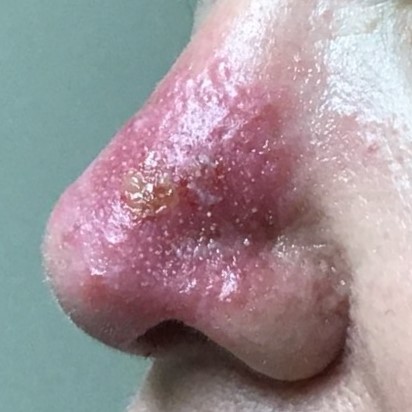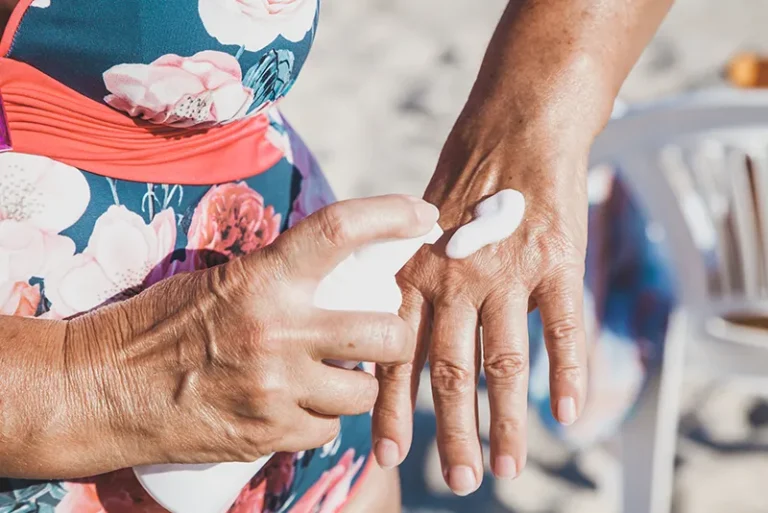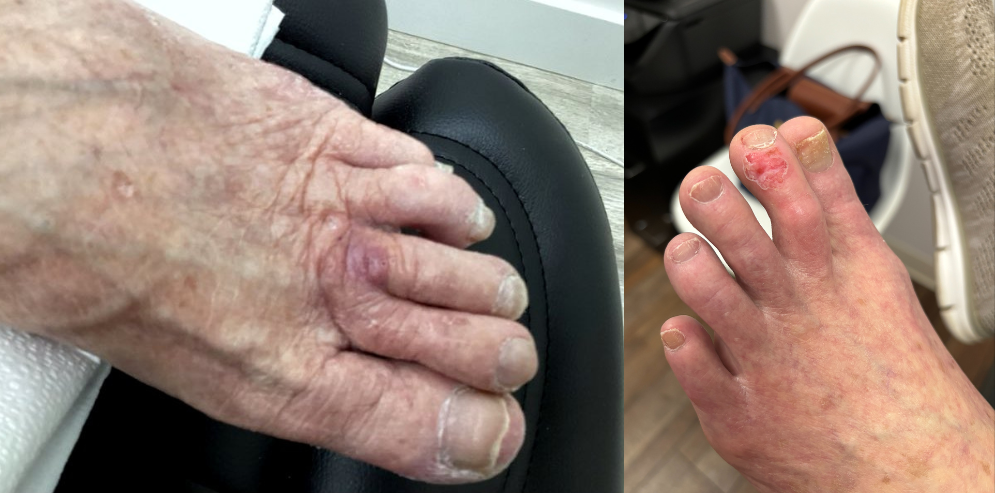
The most common types of skin cancer that appear on the nose are basal cell skin cancer, squamous cell skin cancer, and melanoma. The nose is a common location for skin cancer to develop, because it gets more sun compared to other parts of the body. How do you recognize skin cancer on the nose? And, what can you do to prevent it from developing in the first place? Read on to learn more about early warning signs, risk factors, prevention, and treatment.
Beginning Signs of Skin Cancer on the Nose
Skin cancer can appear anywhere on the body. When it shows up on the surface of the nose, skin cancer can often be mistaken for a pimple, a mole, a rash, or a bug bite. Unlike a pimple or bug bite, though, a skin cancer spot doesn’t heal or go away on its own. Signs of basal cell or squamous cell skin cancer include:
- Reddish patches on your nose that may itch
- Small bumps that are translucent and shiny and have black, blue, or brown areas
- Scar-like areas that are flat and firm, as well as pale or yellow
- Open sores that may bleed but never heal and always come back
- Pink growths with raised edges and visible blood vessels that look like wheel spokes
The most telling sign of melanoma is a new or pre-existing spot on the skin that’s actively changing in color, shape, and size. These spots stand out because they usually look different from the other spots on the skin.
Risk Factors for Developing Skin Cancer on the Nose
Exposure to ultraviolet (UV) rays is the most significant risk factor for developing skin cancer on the nose. Over time, UV rays damage your skin and can cause skin cancer, especially on areas like your face and head. Tanning beds, tanning booths, and sunlamps can also cause cancer and should be avoided, particularly if any of the following apply to you:
- You have light-colored hair and fair or freckled skin
- You have a lot of moles or irregularly shaped moles
- You burn easily or have had sunburns in the past
- You or other members of your family have a history of skin cancer
- You’ve been diagnosed with precancerous skin conditions, such as actinic keratoses or Bowen’s disease
- Certain medications or diseases have weakened your immune system
- You’ve been diagnosed with xeroderma pigmentosum — a rare, inherited condition that doesn’t allow skin cells to repair DNA damage caused by sun exposure
- You’ve been diagnosed with another inherited condition, such as Rombo syndrome, Bazex-Dupré-Christol syndrome, epidermolysis bullosa simplex syndrome, and nevoid basal cell carcinoma syndrome (Gorlin syndrome)
How to Prevent Skin Cancer on the Nose
The easiest way to prevent skin cancer on the nose and other parts of your body is to protect your skin when going outside. Don’t use tanning beds, tanning booths, and sunlamps. Contrary to popular misinformation, they’re not safer than the sun and also cause skin cancer. Before going outside, check the UV Index. If the UV rating is higher than a 3, take the following precautions to protect yourself:
- Stay out of the sun as much as you can.
- Use a broad-spectrum sunscreen with a sun protection factor (SFP) of 15 or higher. Be sure to reapply after about two hours, especially if you’re going swimming.
- Protect your face and head with a wide-brimmed hat.
- Wear sunglasses with UV protection.
Another important way to prevent skin cancer is by checking your skin for any bumps, new moles, redness, or unusual growths. Note anything that looks strange and address it with your dermatologist at your routine screenings.
Skin Cancer on the Nose: Diagnosis & Treatment
If your dermatologist finds an abnormal area on your nose, they’ll likely biopsy it to check for skin cancer. In many cases, the entire skin cancer area is removed during a biopsy, effectively treating the skin cancer. If further treatment is needed, a doctor may recommend the following options:
- Surgery: Mohs surgery is a procedure that removes skin cancer by cutting it out. The pieces of skin and tissue that are removed are examined for cancer cells until the skin cancer area has been fully removed. Reconstructive surgery is often needed as a follow-up to Mohs surgery, especially for procedures that are performed on the face.
- Image-Guided Superficial Radiation Therapy: Image-Guided SRT is a type of radiotherapy that uses low-energy X-rays to shrink common skin cancers, such as basal cell and squamous cell skin cancer. Because this treatment uses ultrasound images, Image-Guided SRT actually shows the skin cancer area disappearing until it’s gone. This form of treatment requires no cutting or surgery, so there’s no wound care after the skin cancer has been removed.
Other forms of treatment for skin cancer on the nose can include immunotherapy, cryotherapy,
topical chemotherapy, photodynamic therapy, and immune response modifiers. The right treatment for your case depends on the skin cancer type and the size of the skin cancer area. One type of skin cancer treatment may be recommended, or a case may require a combination of different treatments.
Learn More About Skin Cancer Treatment with GentleCure™
If you’ve been diagnosed with skin cancer on your nose, Image-Guided Superficial Radiation Therapy may be right for you. GentleCure™ can help you gain access to surgery-free skin cancer treatment that won’t prevent you from doing the things you love. We can connect you with an Image-Guided SRT location near you. To learn more about GentleCure™, contact our skin cancer information specialists online or by phone.








